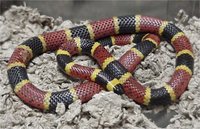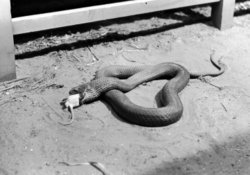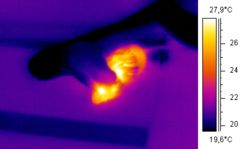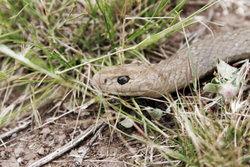|
Snakes |
||||||||||
|---|---|---|---|---|---|---|---|---|---|---|

A
coral snake
|
||||||||||
| Scientific classification | ||||||||||
|
||||||||||
Anomochilidae Boidae Bolyeriidae Cylindrophiidae Loxocemidae Pythonidae Tropidophiidae Uropeltidae Xenopeltidae
Leptotyphlopidae Typhlopidae
Atractaspididae Colubridae Elapidae Hydrophiidae Viperidae |
- Ophidian redirects here. For the collectible card game, see Ophidian 2350.
Snakes (from Old English snaca, and ultimately from the Proto-Indo-European base *snag- or *sneg-, "to crawl"), also known as ophidians, are cold-blooded legless reptiles closely related to lizards, which share the order Squamata. There are also several species of legless lizard which superficially resemble snakes, but are not otherwise related to them. A love of snakes is called ophiophilia, a fear of snakes is called ophidiophobia. A specialist in snakes is an ophiologist.
An old synonym for snake is serpent (which comes from Old French, and ultimately from *serp-, "to creep"[1]); in modern usage this usually refers to a mythic or symbolic snake, and information about such creatures can be found under serpent (symbolism). This article deals with the biology of snakes.
Contents |
Evolution
Recent fossil evidence suggests that snakes directly evolved from burrowing lizards, either varanids or some other group. An early fossil snake, Najash rionegrina, was a two-legged burrowing animal with a sacrum, fully terrestrial. One extant analog of these putative ancestors is the earless monitor Lanthanotus of Borneo, although it also is semi-aquatic. As these ancestors became more subterranean, they lost their limbs and became more Features such as the transparent, fused eyelids and loss of external ears, according to this hypothesis, evolved to combat Modern boas do have vestigal hind limbs, tiny, clawed digits known as anal spurs and used to grasp during mating.
The alternative hypothesis, based on the land much like they are today. Fossil snake remains are known from early Late Cretateous marine sediments, which is consistent with this hypothesis, particularly as they are older than the terrestrial Najash rionegrina. Similar skull structure; reduced/absent limbs; and other anatomical features found in both mosasaurs and snakes lead to a positive cladistical correlation, though some features are also shared with varanids. Supposedly similar locomotion for both groups is also used as support for this , and (it has been claimed) therefore not to mosasaurs, the proposed ancestor in the aquatic scenario of their evolution. However, there is more evidence linking ]] of mammals following the extinction of the dinosaurs.
Prey

All snakes are carnivorous, eating small animals including lizards and other snakes, rodents and other small mammals, birds, eggs or insects. Some snakes have a venom bite which they use to kill their prey before eating it. Other snakes kill their prey by constriction. Still others swallow their prey whole and alive. Most snakes are very easy to feed in captivity, apart from a minority of species.
Snakes do not chew their food and have a very flexible lower jaw, the two halves of which are not rigidly attached, and numerous other joints in their skull (see snake skull), allowing them to open their mouths wide enough to swallow their prey whole, even if it is larger in diameter than the snake itself. It is a common misconception that snakes actually dislocate their lower jaw to consume large prey.
After eating, snakes become torpid while the process of digestion takes place. Digestion is an intensive activity, especially after the consumption of very large prey. In species which feed only sporadically, the entire intestine enters a reduced state between meals to conserve energy, and the digestive system is 'up-regulated' to full capacity within 48 hours of prey consumption. So much metabolic energy is involved in digestion that in Crotalus durissus, the Mexican rattlesnake, an increase of body temperature to as much as 14 degrees Celsius above the surrounding environment has been observed.[2] Because of this, a snake disturbed after having eaten recently will often regurgitate its prey in order to be able to escape the perceived threat. However, when undisturbed, the digestive process is highly efficient, dissolving and absorbing everything but hair and claws, which are excreted along with uric acid waste. Snakes have been known to occasionally die from trying to swallow an animal that is too big. Snake digestive acids are unable to digest most plant matter, which passes through the digestive system mostly untouched.
Snakes do not normally prey on people, but there are instances of small children being eaten by large constrictors in the jungle. While some particularly aggressive species exist, most will not attack humans unless startled or injured, preferring instead to avoid contact. The majority of snakes are either non-venomous or possess venom that is not harmful to humans.
As a general rule, snakes eat rodents. There are exceptions to this, such as the natal green snake, which eats insects. Snakes generally pick a few food types to specialise in (for example, royal pythons will generally eat mice and gerbils in the wild).
Skin
The skin is covered in scales. Most snakes use specialized belly scales to move, gripping surfaces. The body scales may be smooth, keeled, or granular. Their eyelids are transparent "spectacle" scales which remain permanently closed, called brille. They shed their skin periodically. Unlike other reptiles, this is done in one piece, like pulling off a sock, with the snake rubbing its nose against something rough, like a rock, for instance, creating a rip in the skin around the nose and the mouth until the skin is completely removed.[1] The primary purpose of shedding this is to grow; shedding also removes external parasites. This periodic renewal has led to the snake being a symbol of healing and medicine, as pictured in the Rod of Asclepius. In "advanced" (Caenophidian) snakes, the broad belly scales and rows of dorsal scales correspond to the vertebrae, allowing scientists to count the vertebrae without dissection. If there is not enough humidity in the air while snakes are shedding their skin, it can be very dangerous for the snake, because the dry skin does not shed. Skin that remains attached to the snake can harbour diseases and parasites. A tail tip that is not removed can constrict as the snake grows, cutting off the blood supply to the end of the tail causing it to drop off. A retained spectacle can cause the snake to become blind in the affected eye.
Perception

While snake vision is unremarkable (generally being best in arboreal species and worst in burrowing species), it is able to detect movement. Some snakes, like the Asian vine snake, have binocular vision. In most snakes, the lens moves back and forth within the eyeball to focus. In addition to their eyes, some snakes (pit vipers, pythons, and some boas) have infrared-sensitive receptors in deep grooves between the nostril and eye which allow them to "see" the radiated heat.
Snakes have no external ears, but they do have a bone called the quadrate under the skin on either side of the head which focuses sound into the cochlea.[2] Their sense of hearing is most sensitive to frequencies around 200–300 Hz.
A snake smells by using its forked tongue to collect airborne particles then passing them to the Jacobson's organ or the Vomeronasal organ in the mouth for examination. The fork in the tongue gives the snake a sort of directional sense of smell. The part of the body which is in direct contact with the surface of the ground is very sensitive to vibration, thus a snake is able to sense other animals approaching.
Internal organs
The left lung is very small or sometimes even absent, as snakes' tubular bodies require all of their organs to be long and thin. To accommodate them all, only one lung is functional. This lung contains a vascularized anterior portion and a posterior portion which does not function in gas exchange. This 'saccular lung' may be used to adjust buoyancy in some aquatic snakes and its function remains unknown in terrestrial species. Also, many organs that are paired, such as kidneys or reproductive organs, are staggered within the body, with one located ahead of the other. The most primitive snakes, including boas and pythons, have anal spurs, a pair of claws on either side of the cloaca which are used by the males for stimulation of females during coitus.
Locomotion
Snakes utilize a variety of methods of movement which allows them substantial mobility in spite of their legless condition. All snakes are capable of lateral undulation, in which the body is flexed side-to-side, and the flexed areas propagate posteriorly, giving the overall shape of a posteriorly propagating sine wave. In addition, all snakes are capable of concertina movement. This method of movement can be used to both climb trees and move through small tunnels. In the case of trees, the branch is grasped by the posterior portion of the body, while the anterior portion is extended. The anterior portion then grasps the branch, and the posterior portion is pulled forward. In the case of tunnels, instead of grasping, the body loops are pressed against the tunnel walls to attain traction, but the motion is otherwise similar. Another common method of locomotion is rectilinear locomotion, in which the snake remains straight and propels itself via a caterpillar-like motion of its belly-muscles. This mode is usually only used by very large, heavy snakes, such as large pythons and vipers. The most complex and interesting mode is sidewinding, an undulatory motion used to move across slippery mud or loose sand.
Not all snakes dwell on land; sea snakes live in shallow tropical seas.
Studies of the motion and muscle activity of moving snakes have shed light on how each of these modes is achieved.
In terrestrial lateral undulation, posteriorly propagating unilateral waves of muscle contraction occur. The regions of muscle activity for each side extend from the most concave point on that side posteriorly to the most convex side. Thus, when a point on the snake's body is maximally flexed to the right, the right muscles activate, bending it back to the left until it's maximally right-convex, at which point the right side muscles turn off, and the left side muscles turn on. Speed is modulated primarily by alteration of frequency. Aquatic lateral undulation appears superficially similar, but the muscle activation pattern is different, with the regions of muscle activity being 'shifted' posteriorly to where they would be in terrestrial lateral undulation. The reasons for this difference are not fully understood.
Sidewinding, though it appears complex and confusing, is actually a simple modification of terrestrial lateral undulation. At the points of maximal flexion, the dorsalmost muscle group (traversospinalis group) activates, lifting that portion of the body over the ground, and resulting in other portions of the body remaining in static contact. This mode is used to cross slick surfaces such as mud flats and sand, and has nothing to do with thermoregulation, as is sometimes erroneously stated. Many species of snake, including species commonly kept as pets and which do not usually encounter deserts or mud flats, will sidewind when placed on a slick floor or tabletop and enticed to move fast.
Concertina locomotion and rectilinear locomotion are less well understood. Studies of muscle activity have only been done for tunnel concertina locomotion, which shows that the muscles are unilaterally active in static regions of bending in order to brace the snake against the tunnel walls. Rectilinear is believed to rely on different muscles from the other modes; while they all rely on the large epaxial muscles, rectilinear locomotion seems to rely upon the small costocutaneous muscles. However, this has not been verified experimentally, due to the difficulties in working with these small muscles.
"Flying" snakes
Several species of snake have the ability to glide, all being in the genus Chrysopelea. They are quite capable at it, able to travel as far as 13.7 metres through the air. They tend to make slithering motions to steer and help propel themselves along, propulsion being something unusual among the many gliding animals. This has contributed, in ancient times, to the belief in Wyrms (Legless, snake-like dragons that could supposedly fly.)
Reproduction
A wide range of reproductive modes are used by snakes. All snakes employ internal fertilization, accomplished by means of paired, forked hemipenes, which are stored inverted in the male's tail. Most snakes lay eggs, and of those most species abandon them shortly after laying; however, some species are ovoviviparous and retain the eggs within their bodies until they are almost ready to hatch. Recently, it has been confirmed that several species of snake are fully viviparous, nourishing their young through a placenta as well as a yolk sac, highly unusual among reptiles, or indeed anything else outside of placental mammals. Retention of eggs and live birth are commonly, but not exclusively, associated with cold environments, as the retention of the young within the female allows her to control their temperature more effectively than if the developing young were in external eggs.
Snake bites
Documented deaths resulting from snake bites are uncommon in most areas of the world. Only about 450 species of snakes are venomous (with only about 250 that are able to kill a human), and among the 7,000 Americans bitten by venomous snakes every year, fewer than fifteen die (lightning kills more).
Venomous snakes
A venomous snake is a snake that uses modified saliva, venom, delivered through fangs in its mouth, to immobilize or kill its prey. (In contrast, most non-venomous species are constrictors which suffocate their prey.) Snake venom can be either a neurotoxin or a hemotoxin. Neurotoxins attack the nervous system, while hemotoxins attack the circulatory system. Venomous snakes include several families of snakes and do not constitute a formal classification group used in taxonomy.
Venomous snakes that use heomotoxins usually have their fangs to secrete the venom in the front of their mouths, making it easier for them to inject the venom into their victims. Snakes that use neurotoxins, such as the highly venomous mangrove snake, have their fangs located in the back of their mouths, with the fangs curled backwards. This makes it both difficult for the snake to use its venom and for scientists to milk them.
Evolution of Snakes
A loose joint developed in the bottom jaw of even the most primitive extinct snakes.
Venomous snakes are generally classified in four taxonomic families:
- Elapids - cobras, king cobras, kraits, mambas,
Australian copperheads, and coral snakes.
Viperids - vipers, rattlesnakes, copperheads/cottonmouths, adders and bushmasters.
Colubrids - boomslangs, tree snakes, vine snakes, mangrove snakes, and many others, though not all colubrids are venomous.
Hydrophiidae - sea snakes

Snake charmers
In some parts of the world, especially in India and Pakistan, snake charming is a roadside show performed by a charmer. In this, the snake charmer carries a basket that contains a snake which he seemingly charms by playing tunes from his flute-like musical instrument, to which the snake responds. However, snakes' sense of hearing is not very sensitive to the range of the charmer's instrument, so they may not be able to hear the music at all. Researchers have pointed out that many of these snake charmers are good sleight-of-hand artists. The snake moves corresponding to the flute movement and the vibrations from the tapping of the charmer's foot which is not noticed by the public. They rarely catch their snakes and the snakes are either nonvenomous or defanged cobras. Sometimes these people exploit the fear of snakes by releasing snakes into the neighbourhood and then offering to rid the residence of snakes. Other snake charmers also have a snake and mongoose show, where both the animals have a mock fight; however, this is not very common, as the snakes, as well as the mongooses, may be seriously injured or killed.
Snake charming as a profession is now dissuaded in India as a contribution to forest & snake conservation. In fact in some places in India snake charming is banned by law.
Snake trapping
Despite the existence of snake charmers, there have also been professional snake catchers or wranglers. The tribals of "Irulas" from Andhra Pradesh and Tamil Nadu in India have been practicing this art for generations. They generally don't use gimmicks and with the help of a simple stick catch the snakes from the fields or houses. They are also known to eat some of the snakes they catch and are very useful in rat extermination in the villages. Their knowledge of snakes and their behaviour is uncanny. Modern day snake trapping involves a herpetologist using a long stick with a "V" shaped end. Some like Steve Irwin prefered to catch them using bare hands.
At least one tribe of natives uses a specialized form of snake catching as a rite of passage to manhood. The young man of interest will wrap his leg heavily in some type of cloth all the way to the inseam. He will then stick his leg in a burrow containing a large python, typically a reticulated python. After the snake swallows most of his leg several other members of the tribe will pull him out of the hole along with the snake. The snake is then killed and the man's leg removed from the snake. These snakes can be over 20 ft long and it is possible for the man to have his leg dislocated. The scent of a prey animal may be used to help convince the snake to swallow the leg. Snakes have a single-track digestive system, but the digestion process actually takes longer.
Human consumption of snakes
In some cultures, the consumption of snakes is acceptable[3] or even considered a delicacy[4], prized for its alleged pharmaceutical effect of warming the heart. Western cultures document the consumption of snake under extreme circumstances of hunger[5]. However, human consumption of snake meat, especially when eaten raw, may lead to dangerous parasitic infections in humans. Cooked Rattlesnake meat is eaten in the western United States somewhat commonly. In Asian countries drinking the blood of snakes, particularly the cobra, is believed to increase sexual virility. The blood is drained while the cobra is still alive when possible, and is usually mixed with some form of liquor to improve the taste.
Symbolism
In Egyptian history, the snake occupies a primary role with the Nile cobra adorning the crown of the pharaoh in ancient times. It was worshipped as one of the Gods and was also used for sinister purposes: murder of an adversary and ritual suicide (Cleopatra).
In Greek Mythology snakes are often associated with deadly and dangerous antagonists. The 9 headed Hydra Hercules defeated and the three Gorgon sisters are literary examples. Medusa was one of the three Gorgon sisters who Perseus defeated. Medusa is described as a hideous mortal, with snakes instead of hair and the power to turn men to stone with her gaze.
Two medical symbols involving snakes that are still used today are Bowl of Hygieia, symbolizing pharmacy, and the Caduceus and Rod of Asclepius, which are symbols denoting medicine in general.
India is often called the land of snakes and is steeped in tradition regarding snakes. Snakes are worshipped as gods even today with many women pouring milk on snake pits (despite snakes' aversion for milk). The cobra is seen on the neck of Shiva and Vishnu is depicted often as sleeping only on a 7 headed snake. There are also several temples in India solely for cobras sometimes called Nagraj (King of Snakes) and it is believed that snakes are symbols of fertility. There is a Hindu festival called Nagpanchami each year on which day snakes are venerated and prayed to.
In Christianity the snake makes its infamous appearance in the first book (Genesis) of the Bible when a snake appears before the first couple Adam and Eve and tempts them with the forbidden fruit. It is also seen in Exodus when Moses, as a sign of God's power, turns his stick into a snake; snakes are similarly produced by the pharaoh's magic-practicing priests, but Moses' snake devours them. Later Moses made Nehushtan, a bronze snake on a pole that when looked at cured the people of bites from the snakes that plagued them in the desert. Jesus instucted his disciples to be be as shrewd as snakes and as innocent as doves.
The Ouroboros is a symbol that is associated with many different religions and customs, and is also claimed to be related to Alchemy. The Ouroboros or Oroboros is a snake manifesting its own tail in a clock-wise direction (from the head to the tail) in the shape of a circle, representing manifestation of one's own life and rebirth, leading to immortality.
Snake belongs to one of the 12 celestial animals of Chinese Zodiac, in the Chinese calendar.
In the fictional Harry Potter series, snakes had played an important role, and are mostly associated with the evil chatacters. The snake coming out of a skull is the Dark Mark symbol, used by the Death Eater.
Films
- Snakes on a Plane (2006)
Venom (2005)
Elektra
Harry Potter and the Goblet of Fire (2005)
Harry Potter and the Chamber of Secrets (2002)
A Series of Unfortunate Events (2004)
Anacondas: The Hunt for the Blood Orchid (2004)
Anaconda (1997)
Boa (2000)
Python (2000)
Python II
Boa vs. Python
Raiders of the Lost Ark (1981)
The Jungle Book (1967)
King Cobra
Venomous
Kill Bill Volume 1 and 2
Snake King
Ssss snake
Footnotes
- ^ Definition of serpent - Merriam-Webster Online Dictionary. Merriam-Webster Online Dictionary. Retrieved on 12 October 2006.
- ^ The thermogenesis of digestion in rattlesnakes. Journal of Experimental Biology 207 pp. 579-585. The Company of Biologists (2004). Retrieved on 2006-05-26, 2006.
References
- Romulus Whitaker (English edition); Tamil translation by O.Henry Francis (1996). நம்மை சுட்ரியுள்ள பாம்புகள் (Snakes around us, Tamil). National Book Trust. ISBN 81-237-1905-1.
External links
- Snake Rescue and Reptile Protection in India
- Numerous articles from journals on snakes (mainly Australasian)
- Integrated Taxonomic Information System Serpentes
- EMBL Database
- the Lancelet: "The serpent beguiles?" Explanation of the current controversy over snake origins in the Cretaceous
- The medicinal use of snakes in China
- Poisonous snakes and lizards
- Snake Bites - Outdoor emergency treatment from Survive Outdoors.
- Snake venom LD50 values
- - Care of Snakes as pets